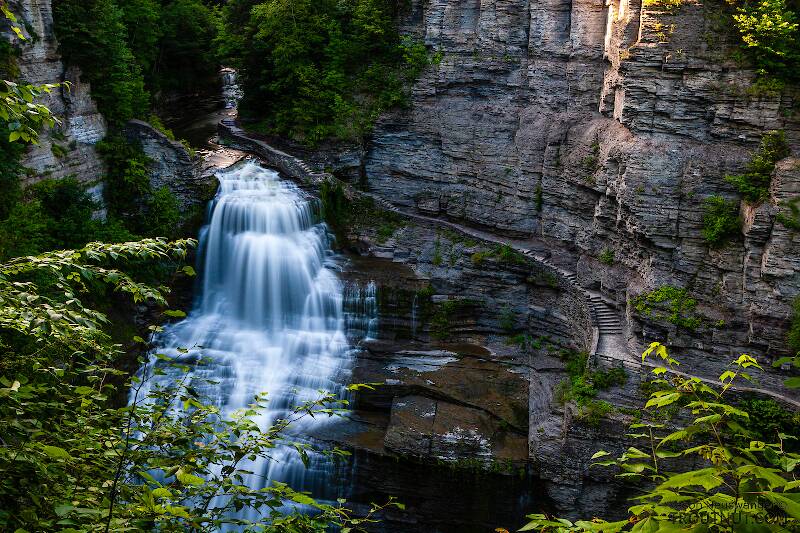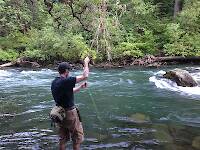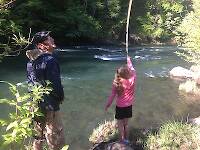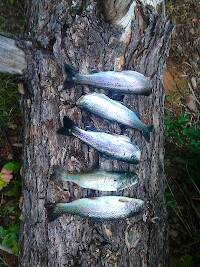
Blue-winged Olives
Baetis
Tiny Baetis mayflies are perhaps the most commonly encountered and imitated by anglers on all American trout streams due to their great abundance, widespread distribution, and trout-friendly emergence habits.
Featured on the forum

This one was surprisingly straightforward to identify. The lack of a sclerite at the base of the lateral hump narrows the field quite a bit, and the other options followed fairly obvious characteristics to Clostoeca, which only has one species, Clostoeca disjuncta.

Troutnut is a project started in 2003 by salmonid ecologist Jason "Troutnut" Neuswanger to help anglers and
fly tyers unabashedly embrace the entomological side of the sport. Learn more about Troutnut or
support the project for an enhanced experience here.
JOHNW on Nov 14, 2007November 14th, 2007, 2:04 pm EST
Ok so the Adams dry, while a standard for most fly anglers, is sorely neglected in my fly box so the parachute version has never even rated as an afterthought. The problem is now I have been informed that this is a must have pattern for an upcoming trip. My question is when hackling a parachute adams do you use both hackles as in the traditional or just a single hackle? If only the single hackle what color? Would a brown dyed grizzly be an effective approach?
Thanks in advance<
John
Thanks in advance<
John
"old habits are hard to kill once you have gray in your beard" -Old Red Barn
Lam on Nov 14, 2007November 14th, 2007, 2:31 pm EST
I am looking at a flyshop-purchased example and it is tied with both the brown and grizzly hackle as is the original dry (non-parachute style).
How rigid you have to stick to that is up for debate, I would think that either the brown died grizzly or the regular grizzly would work just fine on it's own or even the brown hackle by itself. In my humble opinon, the color of the hackle on the parachute style is probably not TOO relevent as you are not immitating a specific species of mayfly anyway, just giving that generic "impression".
How rigid you have to stick to that is up for debate, I would think that either the brown died grizzly or the regular grizzly would work just fine on it's own or even the brown hackle by itself. In my humble opinon, the color of the hackle on the parachute style is probably not TOO relevent as you are not immitating a specific species of mayfly anyway, just giving that generic "impression".
Lam on Nov 14, 2007November 14th, 2007, 2:40 pm EST
I gotta say that I have used the Adams in the past but more and more people keep saying that the parachute version is even more effective. I usually try to match the hatch as far as size and color go. But one time this summer a hatch came off after the sun was pretty well down. The only light I had was from a light on a barn about 50 yards away. I was fishing a long, flat glide that was just erupting with rises. I couldn't see the color of the fly that was hatching and I was a visitor out on my own so I didn't know what fly it might be. Regardless, it was fairly big and so, for the first time I tied on an extended body Adams, probablky a size 12 or 14 hook and proceded to land 5 quick trout, practically cast after cast with a few misses mixed in. The fishing was fabulous for about 25 minutes then it stopped as soon as it began. Could I have used some other large mayfly? Probably. But my respect for the Adams was cemented after that night.
Martinlf on Nov 14, 2007November 14th, 2007, 5:16 pm EST
John,
I'm superstitious about color at times, but have you looked at the bottom of dry fly hackles? They're often very bleached out in terms of matching the color of the top of the feather anyway, so I doubt it matters as much as some might think for most parachutes. I'd think a brown dyed Grizzly would work just fine, and it'd possibly be even better in terms of getting the mixing of shades of color and shade that the Adams is known for than wrapping the two traditional hackles (which also could be a huge pain with small flies). Let us know what you decide and how it works.
All best
Louis--with a "u" that is :)
I'm superstitious about color at times, but have you looked at the bottom of dry fly hackles? They're often very bleached out in terms of matching the color of the top of the feather anyway, so I doubt it matters as much as some might think for most parachutes. I'd think a brown dyed Grizzly would work just fine, and it'd possibly be even better in terms of getting the mixing of shades of color and shade that the Adams is known for than wrapping the two traditional hackles (which also could be a huge pain with small flies). Let us know what you decide and how it works.
All best
Louis--with a "u" that is :)
"He spread them a yard and a half. 'And every one that got away is this big.'"
--Fred Chappell
--Fred Chappell
Flybinder on Nov 14, 2007November 14th, 2007, 8:06 pm EST
John,
Just for my own "two cents", (at today's inflation, that's .75 cents), along with the other 2 gentleman's very valid postings, I'd add in that "color", while important at times, is not a "set law", in fly fishing by any means!
"The Royal Coachman" has, of course, shot the "Must match the hatch, exactly", theory all to pieces, more times than not!
I'd be more interested in the types of water you'll be fishing on this upcoming trip. (If, I were, you, I mean). If you''ll be fishing moving water, the majority of the time, I'd stick with a single hackle parachute, not only for more ease in tying, but also simply to save materials as well was making the fly buoyant, longer, as opposed to TWO wet hackles to keep dry.
Mainly, though, in the micro-split-second, that any fish is going to have to see your fly, as it rapidly sails past their "window of vision", they are going to be solely interested in the silhouette of the imitation, not its exact coloring.
If you are concerned with the color issue, though, sighting the excellent point made already, about "the undersides of hackles, usually being bleached out lighter", you can soak a grizzly hackle in a strong batch of Black Tea, to help equal out the coloring, staining the underside of the hackle a closer shade to the top.
Whatever you choose to do, do ONE thing........ report back, HERE, and the success of your trip! Have fun, be safe and keep your net full!
Just for my own "two cents", (at today's inflation, that's .75 cents), along with the other 2 gentleman's very valid postings, I'd add in that "color", while important at times, is not a "set law", in fly fishing by any means!
"The Royal Coachman" has, of course, shot the "Must match the hatch, exactly", theory all to pieces, more times than not!
I'd be more interested in the types of water you'll be fishing on this upcoming trip. (If, I were, you, I mean). If you''ll be fishing moving water, the majority of the time, I'd stick with a single hackle parachute, not only for more ease in tying, but also simply to save materials as well was making the fly buoyant, longer, as opposed to TWO wet hackles to keep dry.
Mainly, though, in the micro-split-second, that any fish is going to have to see your fly, as it rapidly sails past their "window of vision", they are going to be solely interested in the silhouette of the imitation, not its exact coloring.
If you are concerned with the color issue, though, sighting the excellent point made already, about "the undersides of hackles, usually being bleached out lighter", you can soak a grizzly hackle in a strong batch of Black Tea, to help equal out the coloring, staining the underside of the hackle a closer shade to the top.
Whatever you choose to do, do ONE thing........ report back, HERE, and the success of your trip! Have fun, be safe and keep your net full!
Flybinder:
"You should'a been here, NEXT week,the fishing's great!"
"You should'a been here, NEXT week,the fishing's great!"
Dano on Nov 15, 2007November 15th, 2007, 1:16 am EST
John,
For the most part, I tie my Adams in the "traditional" manner, however, when I have tied it parachute style I've gone with the original tail and hackle colors (otherwise it wouldn't be an Adams). I really can't say if one style is more effective than the other (too many variables) but, I agree with Swisher and Richards that parachutes are more representative of Mayflies on the water.
With that being said, the parachutes that I do tie up on a regular basis I do go with a single hackle. In my view presentation and size are more important than color....FWIW.
Dano
For the most part, I tie my Adams in the "traditional" manner, however, when I have tied it parachute style I've gone with the original tail and hackle colors (otherwise it wouldn't be an Adams). I really can't say if one style is more effective than the other (too many variables) but, I agree with Swisher and Richards that parachutes are more representative of Mayflies on the water.
With that being said, the parachutes that I do tie up on a regular basis I do go with a single hackle. In my view presentation and size are more important than color....FWIW.
Dano
JOHNW on Nov 15, 2007November 15th, 2007, 8:27 am EST
Thanks for the input gentlemen. I have a tendancy to want to lean toward accuracy when tying traditional patterns and their progeney. For example I actually sought out a source for Tup's wool to tie some Tup's Indispensible. Unfortunatly that has subsequently dried up but I digress.
I will probably go with the brown dyed grizzlyfor the following reasons
1. most uniform color top to bottom
2. closest to original while maintaining an economy of materials
Of course I will probably hedge and have a couple of single grizzly hackled ties along.
Just to provide a little more background. The trip in question is actually slated for the beginning of August to the South Fork of the Flat Head in the Bob Marshall Wilderness. I'm particularly excited about this trip for the potential to catch a bull trout or two in addition to seeing a truly wild river full of Westslopes.
JW
I will probably go with the brown dyed grizzlyfor the following reasons
1. most uniform color top to bottom
2. closest to original while maintaining an economy of materials
Of course I will probably hedge and have a couple of single grizzly hackled ties along.
Just to provide a little more background. The trip in question is actually slated for the beginning of August to the South Fork of the Flat Head in the Bob Marshall Wilderness. I'm particularly excited about this trip for the potential to catch a bull trout or two in addition to seeing a truly wild river full of Westslopes.
JW
"old habits are hard to kill once you have gray in your beard" -Old Red Barn
Martinlf on Nov 16, 2007November 16th, 2007, 7:02 pm EST
Need a chaperone so your wife won't worry about those cowgirls putting the moves on you, John? I'll promise her that I'll keep you honest you sly dog, you. In all seriousness, it sounds like a great the trip, but you won't be using those Adams on the Bull Trout, now will you? I'll bet you're tying up some big ugly streamers too.
"He spread them a yard and a half. 'And every one that got away is this big.'"
--Fred Chappell
--Fred Chappell
JOHNW on Nov 17, 2007November 17th, 2007, 1:46 pm EST
Louis,
Shenks "chewy flies" in #2-6 6xl as well as a few double bunnies and buggers will make the arsenal for the Bull's.
As for the chaperone we actually have a slot or two available however we have to make sure that "Lois" isn't going.
JW
Shenks "chewy flies" in #2-6 6xl as well as a few double bunnies and buggers will make the arsenal for the Bull's.
As for the chaperone we actually have a slot or two available however we have to make sure that "Lois" isn't going.
JW
"old habits are hard to kill once you have gray in your beard" -Old Red Barn
Martinlf on Nov 18, 2007November 18th, 2007, 4:23 pm EST
John, it there's any way in hell I could make it, I'd be signing myself up, but financial embarrassment and some other commitments preclude having me (or my sex-changed alter ego) tag along. I will be glad to hear tales of what I miss though.
"He spread them a yard and a half. 'And every one that got away is this big.'"
--Fred Chappell
--Fred Chappell
JOHNW on Nov 19, 2007November 19th, 2007, 11:44 am EST
Louis and Lois,
There will be significant photo documentation of said trip as the same group went to Yellowstone 3 summers ago and shoot well over 4000 frames. That of course worked out to something in the neighborhood of 400 really good shots when the review and editing process was finished. Although the Nevada Pale ale may have influenced our judgement during the whole process.
JW
There will be significant photo documentation of said trip as the same group went to Yellowstone 3 summers ago and shoot well over 4000 frames. That of course worked out to something in the neighborhood of 400 really good shots when the review and editing process was finished. Although the Nevada Pale ale may have influenced our judgement during the whole process.
JW
"old habits are hard to kill once you have gray in your beard" -Old Red Barn
Quick Reply
Related Discussions
Topic
Replies
Last Reply
Re: Big Green River, Wisconsin, late September
In the Mayfly Species Baetis brunneicolor by Admiralb
In the Mayfly Species Baetis brunneicolor by Admiralb
1
Sep 30, 2013
by Entoman
by Entoman
Re: Does the extremely easily tied f-fly perform as well as the parachute adams?
In Fly Tying by Ffly
In Fly Tying by Ffly
25
Jun 15, 2016
by Flytyerinpa
by Flytyerinpa






